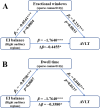Alterations of Excitation-Inhibition Balance and Brain Network Dynamics Support Sensory Deprivation Theory in Presbycusis
- PMID: 39502006
- PMCID: PMC11538860
- DOI: 10.1002/hbm.70067
Alterations of Excitation-Inhibition Balance and Brain Network Dynamics Support Sensory Deprivation Theory in Presbycusis
Abstract
Sensory deprivation theory is an important hypothesis involving potential pathways between hearing loss and cognitive impairment in patients with presbycusis. The theory suggests that prolonged auditory deprivation in presbycusis, including neural deafferentation, cortical reallocation, and atrophy, causes long-lasting changes and reorganization in brain structure and function. However, neurophysiological changes underlying the cognition-ear link have not been explored. In this study, we recruited 98 presbycusis patients and 60 healthy controls and examined the differences between the two groups in gamma-aminobutyric acid (GABA) and glutamate (Glu) levels in bilateral auditory cortex, excitation-inhibition (E/I) balance (Glu/GABA ratio), dynamic functional network connectivity (dFNC), hearing ability and cognitive performance. Then, correlations with each other were investigated and variables with statistical significance were further analyzed using the PROCESS Macro in SPSS. GABA levels in right auditory cortex and Glu levels in bilateral auditory cortex were lower but E/I balance in right auditory cortex were higher in presbycusis patients compared to healthy controls. Hearing assessments and cognitive performance were worse in presbycusis patients. Three recurring connectivity states were identified after dFNC analysis: State 1 (least frequent, middle-high dFNC strength with negative functional connectivity), State 2 (high dFNC strength), and State 3 (most frequent, low dFNC strength). The occurrence and dwell time of State 3 were higher, on the other hand, the dwell time of State 2 decreased in patients with presbycusis compared to healthy controls. In patients with presbycusis, worse hearing assessments and cognition were correlated with decreased GABA levels, increased E/I balance, and aberrant dFNC, decreased GABA levels and increased E/I balance were correlated with decreased occurrence and dwell time in State 3. In the mediation model, the fractional windows, as well as dwell time in State 3, mediated the relationship between the E/I balance in right auditory cortex and episodic memory (Auditory Verbal Learning Test, AVLT) in presbycusis. Moreover, in patients with presbycusis, we found that worse hearing loss contribute to lower GABA levels, higher E/I balance, and further impact aberrant dFNC, which caused lower AVLT scores. Overall, the results suggest that a shift in E/I balance in right auditory cortex plays an important role in cognition-ear link reorganization and provide evidence for sensory deprivation theory, enhancing our understanding the connection between neurophysiological changes and cognitive impairment in presbycusis. In presbycusis patients, E/I balance may serve as a potential neuroimaging marker for exploring and predicting cognitive impairment.
Keywords: GABA; cognitive impairment; dynamic functional network connectivity; excitation–inhibition balance; presbycusis; sensory deprivation theory.
© 2024 The Author(s). Human Brain Mapping published by Wiley Periodicals LLC.
Conflict of interest statement
The authors declare no conflicts of interest.
Figures






Similar articles
-
Neurochemical and functional reorganization of the cognitive-ear link underlies cognitive impairment in presbycusis.Neuroimage. 2023 Mar;268:119861. doi: 10.1016/j.neuroimage.2023.119861. Epub 2023 Jan 5. Neuroimage. 2023. PMID: 36610677 Free PMC article.
-
Aberrant auditory metabolite levels and topological properties are associated with cognitive decline in presbycusis patients.Cereb Cortex. 2024 May 2;34(5):bhae181. doi: 10.1093/cercor/bhae181. Cereb Cortex. 2024. PMID: 38715406
-
Decreased auditory GABA+ concentrations in presbycusis demonstrated by edited magnetic resonance spectroscopy.Neuroimage. 2015 Feb 1;106:311-6. doi: 10.1016/j.neuroimage.2014.11.023. Epub 2014 Nov 15. Neuroimage. 2015. PMID: 25463460 Free PMC article.
-
Central auditory aging: GABA changes in the inferior colliculus.Exp Gerontol. 1995 May-Aug;30(3-4):349-60. doi: 10.1016/0531-5565(94)00052-5. Exp Gerontol. 1995. PMID: 7556513 Review.
-
Cross-modal plasticity in developmental and age-related hearing loss: Clinical implications.Hear Res. 2017 Jan;343:191-201. doi: 10.1016/j.heares.2016.08.012. Epub 2016 Sep 6. Hear Res. 2017. PMID: 27613397 Free PMC article. Review.
References
MeSH terms
Substances
Grants and funding
- 81601479/National Natural Science Foundation of China
- tstp20240525/Taishan Scholars Project of Shandong Province
- ZR2021MH030/Shandong Provincial Natural Science Foundation of China
- ZR2021MH355/Shandong Provincial Natural Science Foundation of China
- 2019QL023/Academic Promotion Programme of Shandong First Medical University
LinkOut - more resources
Full Text Sources

